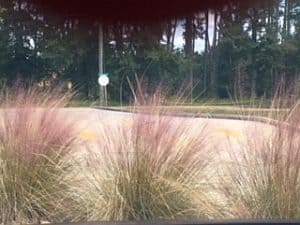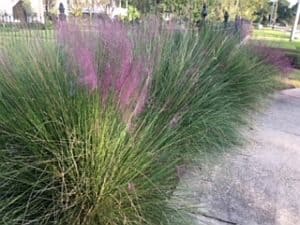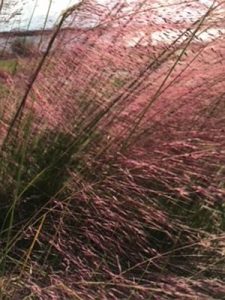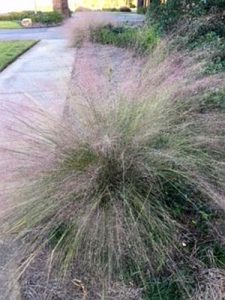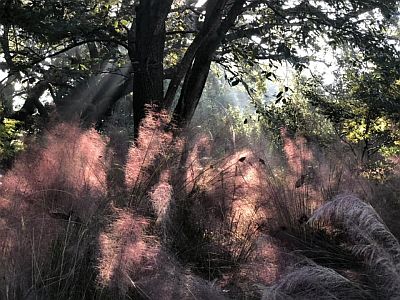
Gulf Muhly Grass/Pink Muhly Grass
I confess to being a sometimes, fickle gardener. If a plant catches my eye, I have to have it. I can’t help notice the pink muhly grass around town and the city right now. Muhlenbergia capillaris is the scientific name for pink muhly grass. Fall is a great time to appreciate this ornamental grass and others, as their flower plumes, known as inflorescences are in their full glory. One of the best and showier grasses, Gulf Muhly grass or pink muhly grass is a native ornamental grass to the gulf coast that shows off with stunning pink/purplish color in the fall and winter.
This grass has a unique texture with spiky, upright leaves that have summer interest. But it’s the fall and winter that really creates landscape excitement. The grass flowers in billowy masses that resemble pink clouds. As long as there isn’t a hard freeze, the color will hold all winter. Even after freezing temperatures, the flower heads keep their airy shape.
Grasses lend themselves well in the landscape and look beautiful in mass, in planters or as a specimen planting. They add texture, form and color as well as movement in the wind. In the fall, as the sun rises, the Gulf Muhly grass can be backlit and glows like a rich, pink cloud or fountain with maximum impact for any garden.
At planting, select a landscape site that receives at least six hours of full sun during fall days. Turn over the soil, and work in at least 2 inches of organic matter. Always set the plant a little bit higher than the native grade of the landscape bed for good drainage. Water well at planting to establish plant. Only minimal fertilizer is needed in April and not much watering. No disease or pest problems bother this plant.
Mass plantings of pink muhly grass is stunning , these plants need their individual space. Each plant can grow up to 4 feet wide, so plant on 3-foot centers. This will achieve that filled-in, mass look. Cut the grass clumps back by 1/3 or 6 inches in late winter before the spring growth starts. Do not cut back any earlier as you will remove the dry inflorescences that create movement with the wind and habitat for wildlife. Propagate by dividing clumps. Cut clumps with a sharp knife or shovel.
There are several varieties available at local nurseries that may fit your needs so read the labels carefully. Gulf muhly grass, known botanically as Muhlenbergia capillaris, has the pink flower heads. Purple muhly or Muhlenbergia filipes grows 4 to 6 feet, has notable late fall color with purple panicles. It is salt tolerant, does well in open coastal woodland on salt dunes. Propagation is by division and seed. Lindheimer’s muhly or Muhlenbergia Lindheimeri grows 3 to 4 feet, available as container grown, fine textured, bluish-gray color grass with purplish flower heads and attractive all year, most showy in fall and does well in mass plantings, drought tolerant and tolerant of a variety of conditions. Propagate by division in spring or by seed. Seep Muhly or Muhlenbergia reverchoni, grows 2 feet and is compact with twisted leaves, purplish seed heads, adapted to dry areas, it will grow in poor gravely soil and is sometimes used in containers.
Submitted by Karen Blackburn

